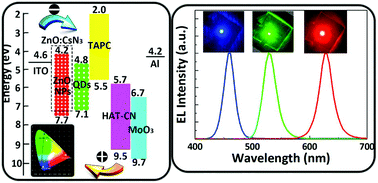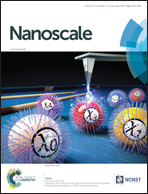Boosting the efficiency of inverted quantum dot light-emitting diodes by balancing charge densities and suppressing exciton quenching through band alignment†
Abstract
We report an inverted and multilayer quantum dot light emitting diode (QLED) which boosts high efficiency by tuning the energy band alignment between charge transport and light emitting layers. The electron transport layer (ETL) was ZnO nanoparticles (NPs) with an optimized doping concentration of cesium azide (CsN3) to effectively reduce electron flow and balance charge injection. This is by virtue of a 0.27 eV upshift of the ETL's conduction band edge, which inhibits the quenching of excitons and preserves the superior emissive properties of the quantum dots due to the insulating characteristics of CsN3. The demonstrated QLED exhibits a peak current efficiency, power efficiency and external quantum efficiency of up to 13.5 cd A−1, 10.6 lm W−1 and 13.4% for the red QLED, and correspondingly 43.1 cd A−1, 33.6 lm W−1 and 9.1% for green, and 4.1 cd A−1, 2.0 lm W−1 and 6.6% for the blue counterparts. Compared with QLEDs without optimization, the performance of these modified devices shows drastic improvement by 95.6%, 39.4% and 36.7%, respectively. This novel device architecture with heterogeneous energy levels reported here offers a new design strategy for next-generation high efficiency QLED displays and solid-state lighting technologies.



 Please wait while we load your content...
Please wait while we load your content...